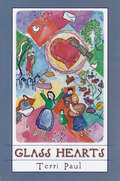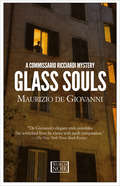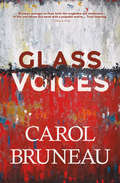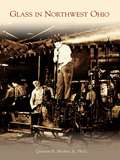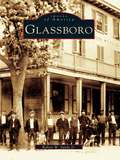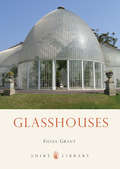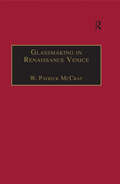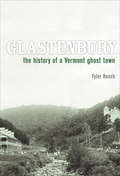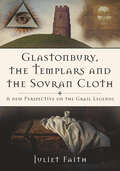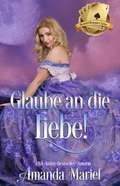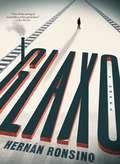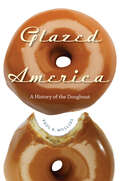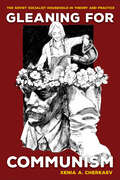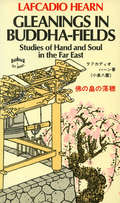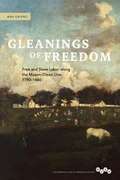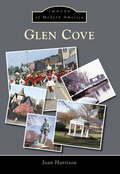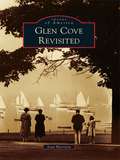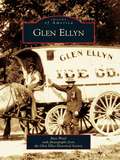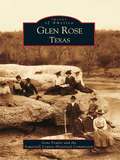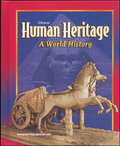- Table View
- List View
Glass Hearts
by Terri PaulA remarkable first novel that centers around Serene, a young girl whose father has vanished from their small Hungarian village just before World War I, leaving his beleaguered Jewish family to fend for themselves. Serene is 5 1/2 years old when we meet her in 1913. For the next six years, she seeks through dreams and visions to recover her father and to deal with the conflicting values and beliefs of her tightly knit family and the society which is unraveling around her.
Glass Souls: A Commissario Ricciardi Mystery (The Commissario Ricciardi Mysteries #8)
by Maurizio de GiovanniThe eighth Commissario Ricciardi historical mystery from the author of The Bottom of Your Heart &“will surprise readers at every turn&” (La Reppublica). In the abyss of a profound personal crisis, Commissario Ricciardi feels unable to open himself up to life. He has refused the love of both Enrica and Livia and the friendship of his partner, Maione. Contentment for Ricciardi proves as elusive as clues to the latest crime he has been asked to investigate. The beautiful, haughty Bianca, countess of Roccaspina, pleads with Ricciardi to investigate a homicide that was officially closed months ago. In the tense, charged atmosphere of 1930s Italy, where Benito Mussolini and his fascist thugs monitor the police closely, an unauthorized investigation is grounds for immediate dismissal and possible criminal charges. But Ricciardi&’s thirst for justice cannot be sated. A tightly plotted historical noir novel, this eighth installment in the Commissario Ricciardi series is a gripping meditation on revenge and justice in which each character&’s soul reveals itself to be made of glass. &“The construction of Glass Souls is remarkable. It&’s like a very sophisticated mosaic in which each protagonist occupies precisely the right amount of space.&” —La Reppublica &“Love, longing, and loss suffuse de Giovanni&’s elegiac, autumnal eighth Commissario Ricciardi mystery set in 1930s Naples . . . Though Ricciardi risks infuriating his bosses—and unknowingly even greater danger from the Fascist forces who have him under surveillance—he can&’t resist the conundrum. Nor in all likelihood will readers.&” —Publishers Weekly &“A must read for those interested in exploring International Noir.&” —Mystery Tribune
Glass Town Wars
by Celia ReesThe thrilling adventure story based on the writings of the Brontë children, by the bestselling author of Witch ChildWhen Tom is in a coma, his friend Milo decides that he can be a guinea pig for a new gaming device - a device that will take him to a troubled world where he meets the the warrior-like Augusta who is fighting to save her kingdom from takeover by her rival. With Tom at her side, she finds extra courage. Slowly but surely, Tom starts to leave his life in London behind as the two of them become ever more embroiled in a world of chaos and tension that encompasses the past, the present and the future.But life in London won't let Tom go so easily. His friends and family gather around him to try and bring him back - as does a girl from school he barely knows, who comes each day to his bedside to read to him from her favourite book, Wuthering Heights.In this wonderful speculative fiction Celia Rees has created a meta-fictional world that will delight readers. This epic story, with Rees's trademark strong female character and romance at its heart, is a compelling action-driven adventure with delightful twists and turns that thrill and surprise right up to the last page.
Glass Voices: 10th Anniversary Edition
by Carol BruneauSurviving the 1917 Halifax Explosion leaves a grieving Nova Scotia couple on a long and difficult road to redemption in this &“textured and rich&” novel (Quill & Quire). Though they survived the Halifax Explosion of 1917, Lucy Caines and her wayward husband, Harry, lost everything in the day&’s terrible events—including their infant daughter. Determined to make peace with their grief and salvage what&’s left of their lives, they begin to rebuild on the rustic shores of Halifax&’s Northwest Arm. But coping isn&’t easy, and each descends into isolation and denial: Lucy through guilt and reticence, and Harry through drinking and gambling. Despite the birth of a treasured son, the couple faces a future clouded by fear and apprehension. Then, fifty-two years after the catastrophe, yet another calamity strikes. Now Lucy must confront the miracle of their survival, reexamine the past, and struggle to become the author of her own happiness.
Glass in Northwest Ohio
by Quentin R. Skrabec Jr.The discovery of natural gas around Findlay in 1886 started an industrial rush in northwest Ohio. Within five years, over 100 glass companies had moved into the region for free gas and railroad connections to the western markets. Unfortunately the gas ran out in just a few years, and many glass companies moved on, but those that stayed changed the nature of the glass industry forever. A brilliant inventor, Michael Owens of Libbey Glass automated the glass-making process after 3,000 years of no change. His automated bottle-making machine changed American life with the introduction of the milk bottle, beer bottle, glass jar, baby bottle, and soda bottle. It also eliminated child labor in the glass factories. Owens also automated the production of fl at glass by 1920. By 1930, over 85 percent of the world's glass was being produced on the machines of Michael Owens, bestowing the title of "Glass Capital of the World" upon northwest Ohio.
Glassboro (Images of America)
by Robert W. Sands Jr.Glassboro is the first illustrated history of the community whose name pays tribute to the industry that made it what it is today. Filled with treasured memories, the book preserves a remarkable collection of vintage photographs that capture historic Glassboro in the past two centuries as a booming southern New Jersey community at the height of its glass industry. The pages are filled with never-before-published images of the Whitney Glass Works, the Warrick-Stanger Glass Works, the Glassboro Auditorium, the Palace Theatre, and other landmarks from long ago.
Glasshouses
by Fiona GrantThe orangeries and glasshouses that stand in the gardens of many stately homes help to tell a three-century story of garden fashion. They reflect both the architectural and social trends of their time, but above all show an increasing ability to tailor the buildings to the needs of the plants within. Starting with the Restoration fashion for cultivating pineapples, oranges and bananas within palatial orangeries, Fiona Grant then explains the development of glasshouses through the eighteenth century into the heyday of diversification and specialisation that charaterized the Victorian period, to the eventual decline of great glasshouses after the First World War. The role of the glasshouse as a display of status and of an interest in botany, technology and architecture is explored, and the book is colorfully illustrated throughout.
Glassmaking in Renaissance Venice: The Fragile Craft
by W. Patrick McCrayThe transformation of the Venetian glass industry during the Renaissance was not only a technical phenomenon, but also a social one. In this volume, Patrick McCray examines the demand, production and distribution of glass and glassmaking technology during this period and evaluates several key topics, including the nature of Renaissance demand for certain luxury goods, the interaction between industry and government in the Renaissance, and technological change as a social process. McCray places in its broader economic and cultural context a craft and industry that has been traditionally viewed primarily through the surviving artefacts held in museum collections. McCray explores the social and economic context of glassmaking in Venice, from the guild and state level down to the workings of the individual glass house. He tracks the dissemination of Venetian-style glassmaking throughout Europe during the sixteenth and seventeenth centuries and its effects on Venice’s glass industry. Integrating evidence from a wide variety of sources - written documents such as shop records and recipe books, pictorial representations of glass and glassmaking, and the careful physical and chemical analysis of glass pieces that have survived to the present - he examines the relation between consumer demand and technological change. In the process, he traces the organizational changes that signified a transition from an older and more traditional manner of ’artisan’ manufacture to a modern, ’factory-style’ manner of production.
Glastenbury: The History of a Vermont Ghost Town (Brief History Ser.)
by Tyler ReschThe curious history of a tiny town that all but disappeared . . . Includes photos! Founded by a famously scheming New Hampshire governor, Glastenbury struggled for over a century to break triple digits in population. A small charcoal-making industry briefly flourished after the Civil War, yet by 1920 Glastenbury counted fewer than twenty inhabitants. The end came officially in 1937, when the state, following a spirited debate, formally disincorporated the town. Yet Glastenbury&’s legacy lives on in Tyler Resch&’s lively and amusing history. Follow Resch as he chronicles the community&’s compelling, if always precarious, existence. From mysterious murders and curious development schemes to the township&’s eventual annexation by the US Forest Service, Glastenbury tells the ultimately redemptive tale of a community that lost its political status, only to gain a national forest.
Glastonbury 50: The Official Story of Glastonbury Festival
by Emily Eavis Michael EavisTHE SUNDAY TIMES BESTSELLERA BOOK OF THE YEAR PICK IN THE TIMES: 'Captivating'A ROUGH TRADE BOOK OF THE YEAR: 'In-depth and inspiring''Beautifully compiled ... the perfect festival experience' SUNDAY TIMESGlastonbury 50 is the authorised, behind-the-scenes, inside story of the music festival that has become a true global phenomenon. The story begins in 1970. The day after Jimi Hendrix's death... dairy farmer Michael Eavis invites revellers to his field in Somerset to attend a 'Pop, Folk & Blues' festival. Tickets are £1 each, enticing more than a thousand customers with the promise of music, dance, poetry, theatre, lights and spontaneous entertainment - as well as free milk from his own Worthy Farm cows.Fast forward through five tumultuous decades and the Eavis's vision now encompasses a gigantic 'city in the fields', with a total annual population nearing a quarter of a million. Tickets sell out within minutes, the show is beamed live to more than 40 countries around the globe, and over 3 million people are registered to attend. Meanwhile, the bill has expanded to include big name performers, artists and designers from every branch of the creative arts. Glastonbury Festival is now the largest outdoor green fields event in the world.In their own words, Michael and Emily Eavis reveal the stories behind the headlines, and celebrate 50 years of history in the Vale of Avalon. They're joined by a host of big-name contributors from the world of music - among them Adele, JAY-Z, Dolly Parton, Chris Martin, Noel Gallagher, Lars Ulrich and Guy Garvey. They're joined by artists - Stanley Donwood, Kurt Jackson and many more. Writers - Caitlin Moran, Lauren Laverne, Billy Bragg - and by a host of photographers, from Seventies icon Brian Walker to rock and roll legends Jill Furmanovsky and Greg Williams.Together they bring you the magic that makes Glastonbury, Glastonbury.
Glastonbury 50: The Official Story of Glastonbury Festival
by Emily Eavis Michael EavisTHE SUNDAY TIMES BESTSELLERA BOOK OF THE YEAR PICK IN THE TIMES: 'Captivating'A ROUGH TRADE BOOK OF THE YEAR: 'In-depth and inspiring''Beautifully compiled ... the perfect festival experience' SUNDAY TIMESGlastonbury 50 is the authorised, behind-the-scenes, inside story of the music festival that has become a true global phenomenon. The story begins in 1970. The day after Jimi Hendrix's death... dairy farmer Michael Eavis invites revellers to his field in Somerset to attend a 'Pop, Folk & Blues' festival. Tickets are £1 each, enticing more than a thousand customers with the promise of music, dance, poetry, theatre, lights and spontaneous entertainment - as well as free milk from his own Worthy Farm cows.Fast forward through five tumultuous decades and the Eavis's vision now encompasses a gigantic 'city in the fields', with a total annual population nearing a quarter of a million. Tickets sell out within minutes, the show is beamed live to more than 40 countries around the globe, and over 3 million people are registered to attend. Meanwhile, the bill has expanded to include big name performers, artists and designers from every branch of the creative arts. Glastonbury Festival is now the largest outdoor green fields event in the world.In their own words, Michael and Emily Eavis reveal the stories behind the headlines, and celebrate 50 years of history in the Vale of Avalon. They're joined by a host of big-name contributors from the world of music - among them Adele, JAY-Z, Dolly Parton, Chris Martin, Noel Gallagher, Lars Ulrich and Guy Garvey. They're joined by artists - Stanley Donwood, Kurt Jackson and many more. Writers - Caitlin Moran, Lauren Laverne, Billy Bragg - and by a host of photographers, from Seventies icon Brian Walker to rock and roll legends Jill Furmanovsky and Greg Williams.Together they bring you the magic that makes Glastonbury, Glastonbury.
Glastonbury, the Templars and the Sovran Cloth: A New Perspective on the Grail Legends
by Juliet FaithThis exciting book sheds new light on the Grail stories and the arrival of Christianity to Somerset. It illustrates important links between Glastonbury and the Celtic settlement at Old Lammana in Cornwall; and examines old tales of an object of great importance - known as ‘the Sovran cloth’ - secretly hidden at both places. The author reveals that Henri de Blois, Abbot of Glastonbury, assisted in the transmission of the Grail stories, and that his family line were in possession of the Shroud and first exhibited it at Lirey in France in 1356. She also examines why there was such great importance placed on oral traditions in ancient times, and what importance these traditions hold for present-day historians. Finally, recent examination of the Templecombe panel reveals why it is believed the Templars may have brought the Shroud to England for safekeeping in 1307. Richly illustrated and compiled using original research, this book is sure to appeal to everyone interested in the Knights Templar and their Somerset history.
Glaube an die Liebe! (Skandal trifft Liebe #5)
by Amanda MarielLady Brooke Linwood konnte nicht ahnen, was passieren würde, nachdem sie gegen den Herzog von Grafton stolperte. Seit ihrer schicksalhaften Begegnung lässt der teuflisch gutaussehende Graf sie nicht mehr in Ruhe und jede Sekunde, die sie gemeinsam verbringen, löst Brookes Widerstand weiter auf. Traut sie sich, an die Liebe zu glauben, oder geht es am Ende nur um ihren Körper? Drake liebt Lady Brooke seit Kindheitstagen und hat ihr einst versprochen, sie zu ehelichen, wenn sie erst erwachsen sind. Doch er konnte nicht wissen, dass ihm sein Vater ein ruiniertes Anwesen und Schulden vererben würde. Drake tat alles, was in seiner Macht stand, um die Angelegenheiten zu regeln, während er jeden Tag davon träumte, endlich Brooke zu sich zu holen. Jetzt, nach zehn langen Jahren, kann er sie endlich für sich beanspruchen. Aber will sie ihn überhaupt noch? Kann eine Liebe aus Kindheitstagen, die zehn Jahre lang in Vergessenheit geraten ist, doch wieder neu entflammen?
Glaxo
by Samuel Rutter Hernan RonsinoGlaxo is a chilling novel of betrayal, romance, and murder, from a major Latin American writer being published in English for the first time.In a derelict town in Argentina's pampa, a decades-old betrayal simmers among a group of friends. One returns from serving time for a crime he didn't commit; another, a policeman with ties to the military regime, discovers his wife's infidelity; a third lays dying. And an American missionary has been killed. But what happened among these men? Spinning through a series of voices and timelines, Glaxo reveals a chilling story of four boys who grow up breaking horses and idolizing John Wayne, only to become adults embroiled in illicit romances, government death squads, and, ultimately, murder. Around them, the city falls apart. Both an austere drama and a suspenseful whodunit, Glaxo crackles with tension and mystery. And it marks the stunning English-language debut of a major Latin American writer.
Glazed America: A History of the Doughnut
by Paul R. MullinsEverybody loves a good doughnut. The magic combination of soft dough, hot oil, and sugar coating--with or without sprinkles--inspires a wide range of surprisingly powerful memories and cravings. Yet we are embarrassed by our desire; the favorite food of Homer Simpson, caricatured as the dietary cornerstone of cops, a symbol of our collective descent into obesity, doughnuts are, in the words of one California consumer, a "food of shame."Paul Mullins turns his attention to the simple doughnut in order to learn more about North American culture and society. Both a breakfast staple and a snack to eat any time of day or night, doughnuts cross lines of gender, class, and race like no other food item. Favorite doughnut shops that were once neighborhood institutions remain unchanged--even as their surrounding neighborhoods have morphed into strip clubs, empty lots, and abandoned housing.Blending solid scholarship with humorous insights, Mullins offers a look into doughnut production, marketing, and consumption. He confronts head-on the question of why we often paint doughnuts in moral terms, and shows how the seemingly simple food reveals deep and complex social conflicts over body image and class structure.In Mullins's skillful hands, this simple pastry provides surprisingly compelling insights into our eating habits, our identity, and modern consumer culture.
Gleam and Glow
by Eve BuntingIt’s too dangerous to stay any longer--the war is coming closer. Viktor, little Marina, and Mama must pack what they can carry and flee their home. As they trudge beside the other refugees, Viktor worries about what lies ahead, and what he’s left behind--his room, his books, the fish Marina loves so much. Even worse, his papa is off fighting with the Liberation Army and doesn’t know they’ve left home. How will Papa ever find them now? Inspired by real events, master storyteller Eve Bunting recounts the harrowing yet hopeful story of a family, a war--and a dazzling discovery.
Gleaning for Communism: The Soviet Socialist Household in Theory and Practice
by Xenia A. CherkaevGleaning for Communism is a historical ethnography of the property regime upon which Soviet legal scholars legislated a large modern state as a household, with guaranteed rights to a commons of socialist property, rather than private possessions. Starting with former Leningrad workers' everyday stories about smuggling industrial scrap home over factory fences, Xenia Cherkaev traces collectivist ethical logic that was central to this socialist household economy, in theory and practice: from its Stalin-era inception, through Khrushchev's major foregrounding of communist ethics, to Gorbachev's perestroika, which unfurled its grounding tension between the interests of any given collective and of the socialist household economy itself. A story of how the socialist household economy functioned, how it collapsed, and how it was remembered, this book is haunted throughout by a spectral image of the totalitarian state, whose jealous political control over the economy leads it to trample over all that which ought to be private. Underlying this image, and the neoliberal state phobia it justified, is the question of how individual interests ought to relate to the public good in a large modern society, which, it is assumed, cannot possibly function by the non-private logics of householding. This book tells the story of a large modern society that did.
Gleanings in Buddha-Fields
by Lafcadio HearnLafcadio Hearn's books continue to charm and captivate readers, as the exotic subjects about which he wrote charmed and captivated him. Gleanings In Buddha-Fields presents more Hearn magic as he enters into the spirit of Buddhism asthough he were born into it. "I an individual," he writes, "an individualsoul! Nay, I am a population-a population unthinkable for multitude, even by groups of a thousand millions! Generations of generations, I am, aeons of aeons! Countless times the concourse now making me has been scattered, and mixed withother scatterings. Of what concern, then, the next disintegration?" (Shades of Walt Whitman!) Hearn says that if he were a god, dwelling in some old Izumo shrine on the summit of a hill, then "as air to the bird, as water to the fish, so would all substance be permeable to the essence of me. I should pass at will into the walls of my dwelling to swim in the long gold bath of a sunbeam, to thrill in the heart of a flower, to ride on the neck of a dragonfly." He writes of a trip to Kyoto, telling of hazy autumn rice fields, with dragonflies darting over the drooping grain; maples crimsoning above a tremendous gorge; ranges of peaks steeped in morning mist; and a peasant's cottage perched on the verge of some dizzy mountain road. Also, there are fine bits of realism, such as a cat seizing a mouse in the act of stealing the offerings placed in a Buddhist household shrine. In the chapter "Dust," Hearn tells of a children's playground, and says that children in all countries play at death. But the idea of ceasing to exist could not possibly enter a child's mind: the butterflies and birds, the flowers, the foliage, the sweet summer itself, only play at dying-they seem to go, but they all come back again after the snow is gone. "The real sorrow and fear of death arise in us only after the slow accumulation of experience with doubt and pain; and these little boys and girls being Japanese and Buddhists will never, in any event, feel about death just as you and I do . . . they have died millions of times already, and have forgotten the trouble of it, much as one forgets the pain of successive toothaches." In "Nirvana," Hearn writes that Buddhism, recognizing no permanency, no finite stabilities, no distinction of character or class or race, except as passing phenomena, is essentially the religion of tolerance. This thought-provoking reprint of an old favorite will delight people of all races and creeds.
Gleanings of Freedom: Free and Slave Labor along the Mason-Dixon Line, 1790-1860
by Max GrivnoLate eighteenth- and early nineteenth-century landowners in the hinterlands of Baltimore, Maryland, cobbled together workforces from a diverse labor population of black and white apprentices, indentured servants, slaves, and hired workers. This book examines the intertwined lives of the poor whites, slaves, and free blacks who lived and worked in this wheat-producing region along the Mason-Dixon Line. Drawing from court records, the diaries, letters, and ledgers of farmers and small planters, and other archival sources, Max Grivno reconstructs how these poorest of southerners eked out their livings and struggled to maintain their families and their freedom in the often unforgiving rural economy.
Glen Canyon Dam
by Timothy L. ParksConstructed between 1956 and 1966 by the United States Bureau of Reclamation, Glen Canyon Dam on the Colorado River was a project of immense proportions. Even before the non-stop pouring of 5 million yards of concrete began, much work had to be accomplished. The town of Page, Arizona was established on a windswept mesa to house workers and their families, and the 1,028-foot Glen Canyon Bridge was built to carry men, materials, and equipment to the dam site. Though the dam has proven a controversial structure throughout its history, the massive undertaking of its construction was an undeniable triumph of ingenuity and determination.
Glen Cove
by Joan HarrisonGlen Cove, the only city located on Long Island's Gold Coast, has long been reinventing itself. After World War II, the farms and estates in the area gave way to suburban development. Modern advancements like the zoom lens, the dimmer switch, and X-ray technologies were all developed within the city limits, while factories on the creek supplied the world with carbon paper, typewriter ribbons, and graphic arts film and cameras. Albert Einstein, Nikita Khrushchev, and the Kennedy families stayed in the community, and stars of stage and screen performed about town. In 1968, Glen Cove celebrated its tricentennial. It was followed by urban renewal and the rebuilding of the old downtown. In the final years of the 20th century, the industrial era ended, and under the auspices of Mayor Thomas Suozzi, environmental cleanup and waterfront revitalization began.
Glen Cove Revisited (Images of America)
by Joan HarrisonSince its founding in the late 17th century as a mill town, Glen Cove has been simultaneously rural and industrial, patrician and working class. A city of multiple ethnicities and close family ties, Glen Cove has been home to generations of immigrants who came to work and stayed to live, as well as to the children of America's elite who built their summer homes on the shores of Hempstead Harbor. In Glen Cove Revisited, "The Heart of the Gold Coast" is seen as only insiders know it, through images of the mill ponds and barnyards, estates and factories, schools and neighborhoods, and the people, famous and unknown, which make up this microcosm of America.
Glen Ellyn (Images of America)
by Russ Ward Glen Ellyn Historical SocietyGlen Ellyn took its name from a Victorian real estate development whose massive promotional campaigns brought this unusually beautiful village to the attention of city dwellers eager to move their families away from the grimy, coal-fired environs of Chicago. Its story begins with hardy New Englanders who felled trees to build log cabins, broke the virgin prairie sod, and trapped wild game in the marshlands that would become greater Chicago, continuing through the radical changes that came with the railroad and the Civil War. From Potawatomi Indians and pioneers to an important Underground Railway station; from a luxurious lakeside health resort with a fabulous grand hotel to one of Chicago's premier suburban communities, Glen Ellyn presents the village's rich history with evocative photographs from the collection of the Glen Ellyn Historical Society.
Glen Rose, Texas (Images of America)
by Gene Fowler Somervell County Historical CommissionCharles Barnard, a Connecticut entrepreneur, settled in the Brazos Valley in 1849, running an Indian Trading Post. He built a gristmill in 1860 near the confluence of the Brazos and Paluxy Rivers, around which the town of Glen Rose sprang up. Captured here in over 200 vintage photographs and postcards is the history of this quintessential little Texas town, from its origins as a mill town, to the bedroom community of Fort Worth that it has become today. In its earliest days, settlers flocked to the region from the war-torn South during the Civil War. By the 1900s, both Somervell County and Glen Rose established fame as a tourist resort, offering springs and artesian waters to heal the body and spirit. Naturopathic and magnetic healers built sanitariums, while locals built tourist parks to entertain the crowds that came for rest and relaxation. Showcased here are images of the Hill postcard collection, which relay the intriguing story of Glen Rose as a recreation mecca, the Moonshine Capital of Texas during Prohibition, the discovery of the infamous dinosaur tracks, and its development as it enters the 21st century.
Glencoe Human Heritage: A World History
by Mcgraw-Hill StaffA storytelling approach that makes world history accessible for every student, Human Heritage: A World History has a variety of features that enhance the easy-to-read text. Invite students to explore the history of the world and its people with this unique middle school program.
